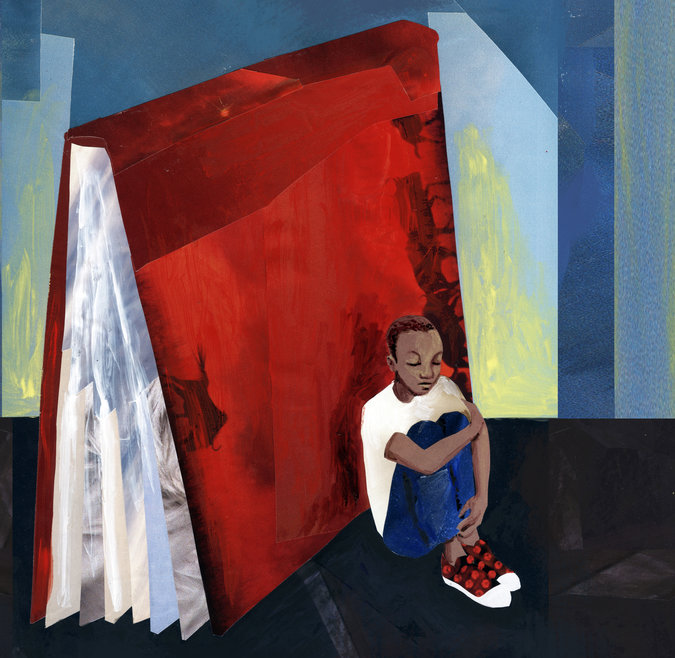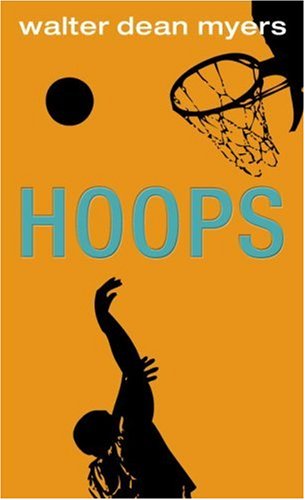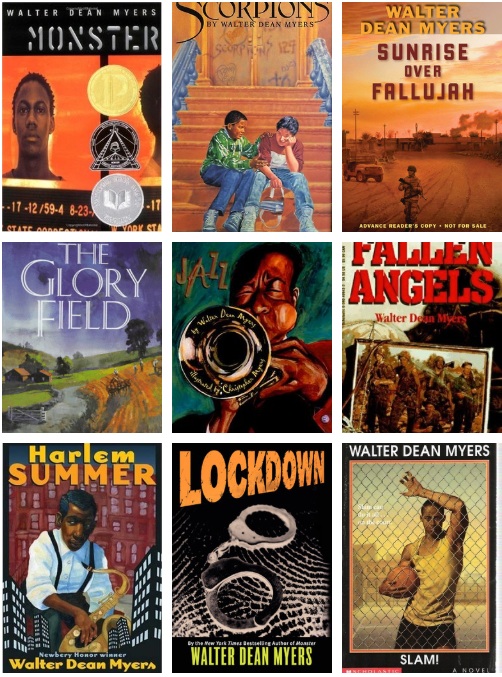MARCH 15, 2014
Where Are the People of Color
in Children’s Books?
By WALTER DEAN MYERS
Of 3,200 children’s books published in 2013, just 93 were about black people, according to a study by the Cooperative Children’s Book Center at the University of Wisconsin.
Reading came early to me, but I didn’t think of the words as anything special. I don’t think my stepmom thought of what she was doing as more than spending time with me in our small Harlem apartment. From my comfortable perch on her lap I watched as she moved her finger slowly across the page. She probably read at about the third grade level, but that was good enough for the True Romance magazines she read. I didn’t understand what the stories were about, what “bosom” meant or how someone’s heart could be “broken.” To me it was just the comfort of leaning against Mama and imagining the characters and what they were doing.
Later, when my sisters brought home comic books, I got Mama to read them to me, too. The magazines and comics pushed me along the road of the imaginative process. When I got my first books — “The Little Engine That Could,” “Bible Stories for Every Day,” and “Goldilocks and the Three Bears” — I used them on the same journeys. In the landscape of my mind I labored as hard as I could to get up the hill. I stood on the plain next to David as he fought Goliath, and tasted the porridge with Goldilocks.
As a teenager I romped the forests with Robin Hood, and trembled to the sound of gunfire with Henry in “The Red Badge of Courage.” Later, when Mama’s problems began to overwhelm her, I wrestled with the demons of dealing with one’s mother with Stephen Dedalus in “A Portrait of the Artist as a Young Man.” But by then I was beginning the quest for my own identity. To an extent I found who I was in the books I read. I was a person who felt the drama of great pain and greater joys, whose emotions could soar within the five-act structure of a Shakespearean play, or find quiet comfort in the poems of Gabriela Mistral. Every book was a landscape upon which I was free to wander.
In the dark times, when my uncle was murdered, when my family became dysfunctional with alcohol and grief, or when I realized that our economics would not allow me to go to college, I began to despair. I read voraciously, spending days in Central Park reading when I should have been going to school.
But there was something missing. I needed more than the characters in the Bible to identify with, or even the characters in Arthur Miller’s plays or my beloved Balzac. As I discovered who I was, a black teenager in a white-dominated world, I saw that these characters, these lives, were not mine. I didn’t want to become the “black” representative, or some shining example of diversity. What I wanted, needed really, was to become an integral and valued part of the mosaic that I saw around me.
Books did not become my enemies. They were more like friends with whom I no longer felt comfortable. I stopped reading. I stopped going to school. On my 17th birthday, I joined the Army. In retrospect I see that I had lost the potential person I would become — an odd idea that I could not have articulated at the time, but that seems so clear today.
My post-Army days became dreadful, a drunken stumble through life, with me holding on just enough to survive. Fueled by the shortest and most meaningful conversation I had ever had in a school hallway, with the one English teacher in my high school, Stuyvesant, who knew I was going to drop out, I began to write short columns for a local tabloid, and racy stories for men’s magazines. Seeing my name in print helped. A little.
Then I read a story by James Baldwin: “Sonny’s Blues.” I didn’t love the story, but I was lifted by it, for it took place in Harlem, and it was a story concerned with black people like those I knew. By humanizing the people who were like me, Baldwin’s story also humanized me. The story gave me a permission that I didn’t know I needed, the permission to write about my own landscape, my own map.
During my only meeting with Baldwin, at City College, I blurted out to him what his story had done for me. “I know exactly what you mean,” he said. “I had to leave Harlem and the United States to search for who I was. Isn’t that a shame?”
When I left Baldwin that day I felt elated that I had met a writer I had so admired, and that we had had a shared experience. But later I realized how much more meaningful it would have been to have known Baldwin’s story at 15, or at 14. Perhaps even younger, before I had started my subconscious quest for identity.
TODAY I am a writer, but I also see myself as something of a landscape artist. I paint pictures of scenes for inner-city youth that are familiar, and I people the scenes with brothers and aunts and friends they all have met. Thousands of young people have come to me saying that they love my books for some reason or the other, but I strongly suspect that what they have found in my pages is the same thing I found in “Sonny’s Blues.” They have been struck by the recognition of themselves in the story, a validation of their existence as human beings, an acknowledgment of their value by someone who understands who they are. It is the shock of recognition at its highest level.
I’ve reached an age at which I find myself not only examining and weighing my life’s work, but thinking about how I will pass the baton so that those things I find important will continue. In 1969, when I first entered the world of writing children’s literature, the field was nearly empty. Children of color were not represented, nor were children from the lower economic classes. Today, when about 40 percent of public school students nationwide are black and Latino, the disparity of representation is even more egregious. In the middle of the night I ask myself if anyone really cares.
When I was doing research for my book “Monster,” I approached a white lawyer doing pro bono work in the courts defending poor clients. I said that it must be difficult to get witnesses to court to testify on behalf of an inner-city client, and he replied that getting witnesses was not as difficult as it sometimes appeared on television. “The trouble,” he said, “is to humanize my clients in the eyes of a jury. To make them think of this defendant as a human being and not just one of ‘them.’ ”
I realized that this was exactly what I wanted to do when I wrote about poor inner-city children — to make them human in the eyes of readers and, especially, in their own eyes. I need to make them feel as if they are part of America’s dream, that all the rhetoric is meant for them, and that they are wanted in this country.
Years ago, I worked in the personnel office for a transformer firm. We needed to hire a chemist, and two candidates stood out, in my mind, for the position. One was a young white man with a degree from St. John’s University and the other an equally qualified black man from Grambling College (now Grambling State University) in Louisiana. I proposed to the department head that we send them both to the lab and let the chief chemist make the final decision. He looked at me as if I had said something so remarkable that he was having a hard time understanding me. “You’re kidding me,” he said. “That black guy’s no chemist.”
I pointed out the degrees on the résumé that suggested otherwise, and the tension between us soared. When I confronted my superior and demanded to know what about the candidate from Grambling made him not a chemist, he grumbled something under his breath, and reluctantly sent both candidates for an interview with the chief chemist.
Simple racism, I thought. On reflection, though, I understood that I was wrong. It was racism, but not simple racism. My white co-worker had simply never encountered a black chemist before. Or a black engineer. Or a black doctor. I realized that we hired people not so much on their résumés, but rather on our preconceived notions of what the successful candidate should be like. And where was my boss going to get the notion that a chemist should be black?
Books transmit values. They explore our common humanity. What is the message when some children are not represented in those books? Where are the future white personnel managers going to get their ideas of people of color? Where are the future white loan officers and future white politicians going to get their knowledge of people of color? Where are black children going to get a sense of who they are and what they can be?
And what are the books that are being published about blacks? Joe Morton, the actor who starred in “The Brother From Another Planet,” has said that all but a few motion pictures being made about blacks are about blacks as victims. In them, we are always struggling to overcome either slavery or racism. Book publishing is little better. Black history is usually depicted as folklore about slavery, and then a fast-forward to the civil rights movement. Then I’m told that black children, and boys in particular, don’t read. Small wonder.
There is work to be done.
__________________________

The news just broke… Walter Dean Myers has passed. In his lifetime, he wrote over 100 books, served as the National Ambassador for Young People’s Literature, won too many awards and honors to list, advised and inspired kids and young writers everywhere, and impacted thousands of lives. He was a lifelong proponent of diversity in children’s literature, and just a few months ago wrote an article that once again sparked the discussion.
Rest well, sir. You will be remembered always.
Beyond this, words fail me.
++++++++++++++++
YA!Flash is moderated by YA writer S.E. Sinkhorn. What you see here is a Tumblr dedicated to all things YA literature, in whatever medium they come. It’s open to submissions, primarily micro-reviews, teen poetry, and flash fiction. I like to be entertained.
>via: http://yaflash.tumblr.com/post/90577481112/the-news-just-broke-walter-dean-myers-has-passed
__________________________
![]()
JULY 2, 2014
Posted BY ELIZABETH BIRD
From Harper Collins:
WALTER DEAN MYERS,
PROLIFIC AND BELOVED
AUTHOR OF
AWARD-WINNING
CHILDREN’S BOOKS,
DIES AT AGE 76
Myers Touched So Many With His Eloquent and Unflinching Portrayal of Young African-American Lives
Walter Dean Myers, beloved and deeply respected children’s book author, died on July 1, 2014, following a brief illness. He was 76 years old.
In a career spanning over 45 years, Walter Dean Myers wrote more than 100 books for children of all ages. His impressive body of work includes two Newbery Honor Books, three National Book Award Finalists, and six Coretta Scott King Award/Honor-winning books. He was the winner of the first-ever Michael L. Printz Award, the first recipient of the Coretta Scott King-Virginia Hamilton Award for Lifetime Achievement, and a recipient of the Margaret A. Edwards Award for lifetime achievement in writing for young adults. In 2010, Walter was the United States nominee for the Hans Christian Andersen Award, and in 2012 he was appointed the National Ambassador for Young People’s Literature, serving a two-year tenure in the position. Also in 2012, Walter was recognized as an inaugural NYC Literary Honoree, an honor given by former New York City Mayor Michael Bloomberg, for his substantial lifetime accomplishments and contribution to children’s literature.
“We are deeply saddened by the passing of erudite and beloved author Walter Dean Myers. Walter’s many award-winning books do not shy away from the sometimes gritty truth of growing up. He wrote books for the reader he once was, books he wanted to read when he was a teen. He wrote with heart and he spoke to teens in a language they understood. For these reasons, and more, his work will live on for a long, long time,” said Susan Katz, President and Publisher of HarperCollins Children’s Books.
Walter Dean Myers was born Walter Milton Myers on August 12, 1937, in Martinsburg, West Virginia. Walter’s birth mother, Mary Myers, died after the birth of his younger sister, Imogene. His father, George, sent Walter to live with his first wife, Florence Dean, and her husband, Herbert Dean, in Harlem, along with Florence and George’s two daughters. Walter would eventually adopt the middle name “Dean” to honor Florence and Herbert.
In Walter’s memoir, Bad Boy, he wrote, “Harlem is the first place called ‘home’ that I can remember.” This sentiment is reflected in Walter’s writing, whether via a love letter to the neighborhood in the picture book Harlem; a story of a boy’s trial for a crime committed in Harlem, in the novel Monster; or the tale of two friends struggling to see a future beyond the community they know in the novel Darius & Twig. Walter spent much of his childhood playing basketball on the courts of Harlem and checking books out of the George Bruce Branch of the New York Public Library. Florence Dean taught Walter to read in their kitchen, and when he began attending Public School 125, he could read at a second-grade level. Though Walter struggled through school with a speech impediment and poor grades, and he had trouble with discipline throughout his school career, he remained an avid reader. His love of reading soon progressed to a love of writing.
Walter wrote well in high school and one teacher, who recognized his talent but also knew he was going to drop out, told him to keep on writing, no matter what—“It’s what you do,” she said. Walter did drop out of Stuyvesant High School, though they now claim him as a graduate (which Walter always found funny). At the age of seventeen, he enlisted in the Army. Years later, after his safe return home and while working a construction job, Walter would remember this teacher’s advice. He started writing again…and he didn’t stop.
Walter’s body of work includes picture books, novels for teens, poetry, and non-fiction alike. In 1968, Walter’s first published book, Where Does the Day Go?, illustrated by Leo Carty, won an award from the Council on Interracial Books for Children. Walter and his son Christopher, an artist, collaborated on a number of picture books for young readers, including We Are America: A Tribute from the Heart and Harlem, which received a Caldecott Honor Award, as well as the teen novel and National Book Award Finalist Autobiography of My Dead Brother, which Christopher illustrated. Walter’s novel Scorpions won a Newbery Honor Medal and the Margaret A. Edwards Award, while gritty teen novels Lockdown and Monster were both National Book Award Finalists. Monster appeared on the New York Times bestseller list, won the first Michael L. Printz Award, and received a Coretta Scott King Honor Award. His stunning Coretta Scott King Award-winning novel, Fallen Angels (1988), about the Vietnam War, was named one of the top ten American Library Association Best Books for Young Adults of all time. Twenty years later, Myers wrote a riveting contemporary companion novel, Sunrise Over Fallujah, which was named a New York Times Notable Book in 2008.
In Invasion (2010), Myers once again explored the effects and horrors of war through young protagonists, this time set in World War II. His upcoming books include Juba!, (HarperCollins, April 2015) a novel for teens based on the life of a young African American dancer, and On a Clear Day (Crown/Random House Books for Young Readers, September 2014). A graphic novel adaptation of Monster (HarperCollins) is also forthcoming.
Walter often wrote books about the most difficult time in his own life—his teenage years—for the reader he once was; these were the books that he wished were available when he was that age. Throughout his life, Walter worked to make sure young adults had the tools necessary to become hungry readers, thirsty learners, and, therefore, successful adults. He frequently met with incarcerated teens in juvenile detention centers and received countless letters thanking him for his inspirational words. Walter also worked with and mentored teenage fan and writer Ross Workman, and they published the novel Kick together. As the National Ambassador for Young People’s Literature from 2012-2013, Walter traveled around the United States promoting the slogan “Reading is not optional.” He strove to spread the message that a brighter future depends on reading proficiency and widespread literacy, not only during his two-year tenure as National Ambassador, but beyond. More than anything, Walter pushed for his stories to teach children and teenagers never to give up on life.
“Walter Dean Myers was a compassionate, wonderful, and brilliant man. He wrote about children who needed a voice and their stories told. His work will live on for generations to come. It was an honor to work with him for so many years,” said Miriam Altshuler, Walter’s literary agent.
Walter lived in Jersey City, New Jersey, with his wife Constance. He is survived by Constance, as well as his two sons, Christopher and Michael Dean. He was predeceased by his daughter, Karen.





